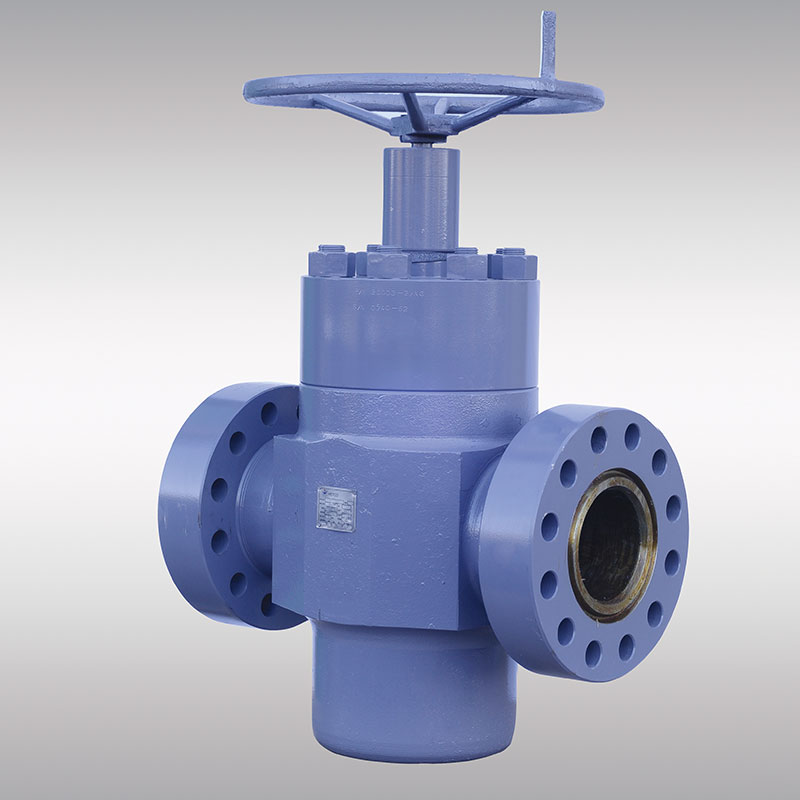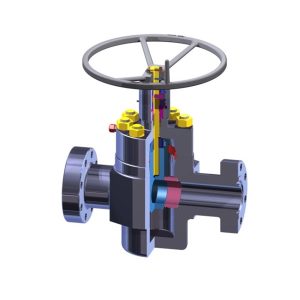API 6A Valves
Gate Valves
Is an important and special mechanical device used in oilfields to control the flow stream by open/close mechanism. Gate valve design in different types to assemble in Christmas tree, wellhead, choke manifold, kill manifold, sand control equipment, etc. and according to the working pressure and temperature.
Gate valves mainly are actuated by a threaded stem that connects the actuator (e.g. hand wheel or motor) to the gate. They are characterized as having either a rising or a non-rising stem, depending on which end of the stem is threaded. Rising stems are fixed to the gate and rise and lower together as the valve is operated, providing a visual indication of valve position. The actuator is attached to a nut that is rotated around the threaded stem to move it. Non-rising stem valves are fixed to, and rotate with, the actuator, and are threaded into the gate. They may have a pointer threaded onto the stem to indicate valve position, since the gate’s motion is concealed inside the valve. Non-rising stems are used where vertical space is limited. HTD’s Gate Valves is designed as follows:
HTD’s Gate Valves are for:
- Environment Temperature: -30°С to +60°С
- Working Temperature: SU (-18℃ ~ 121℃)
- Material Grades: AA, BB, CC, DD, EE, FF, HH
- Specification Level: PSL1 to PSL4
- Performance Level: PR1 to PR2

| Size/WP | 2000 Psi | 3000 Psi | 5000 Psi | 10000 Psi | 15000 Psi |
|---|---|---|---|---|---|
| 1 13/16'' | |||||
| 2 1/16'' | |||||
| 3 1/8'' | |||||
| 4 1/16'' | |||||
| 5 1/8'' | |||||
| 6-3/8'' | |||||
| 7-1/8'' | |||||
| 9'' |

Choke Valves
Is the major component of the Christmas tree and Manifold, mainly used for controlling the production rate of an oil well at a working pressure of up to 20,000 psi. In the extraction of petroleum (and other heavy-duty fluid handling contexts), a choke valve (or “choke”) is an adjustable flow limiter that is designed to operate at a large pressure drop, at a large flow rate, for a long time. The choke valve can be classified as adjustable choke valve and positive choke valve. The adjustable choke valve is designed to adjust the effective area available, for the flow to control the production rate, through rotating the hand wheel. The positive choke valve is designed to control the production rate through changing flow beans.
The most familiar choke design is a solid cylinder (called a “plug” or “stem”) that closely fits inside another cylinder that has multiple small holes through it (the “cage”). Gradually withdrawing the plug uncovers more and more holes, progressively reducing the resistance to flow. If the holes are regularly placed, then the relationship between the position of the valve and the flow coefficient (Cv.) (the flow rate per unit pressure) is roughly linear. Another design places a closely fitted cylindrical “sleeve” around the outside of the cage rather than a plug inside the cage. A choke may also include a conical valve and valve seat, to ensure complete shutoff.
HTD’s Choke Valves are for:
- Nominal Diameter: 1/16” To 4.1/16”
- Working Pressure: 2000 Psi ~ 20000 Psi
- Working Media: Oil, Natural Gas, Mud
- Working Temperature: SU (-18℃ ~ 121℃)
- Material Grades: AA, BB, CC, DD, EE, FF, HH
- Specification Level: PLS1 to PSL4
- Performance Level: PR1 to PR2

Check Valves
Is a valve that normally allows fluid (liquid or gas) to flow through it in only one direction and are manufactured to a high specification from forged steel bodies with stainless internals as standard. Check valves are designed for 2000 psi to 20000 psi working pressure and in size from 1.13/16” to 5.1/8” depending on pressure range.
Check valves are two-port valves, meaning they have two openings in the body, one for fluid to enter and the other for fluid to leave. Check valves work automatically and most are not controlled by a person or any external control; accordingly, most do not have any valve handle or stem
HTD’s Check Valves are for:
- Nominal Diameter: 1/16” ~ 7.1/16”
- Working Pressure: 2000 Psi ~ 20000 Psi
- Working Media: Oil, Natural Gas, Mud
- Working Temperature: SU (-18℃ ~ 121℃)
- Material Grades: AA, BB, CC, DD, EE, FF, HH
- Specification Level: PLS1 to PSL4
- Performance Level: PR1 to PR2




